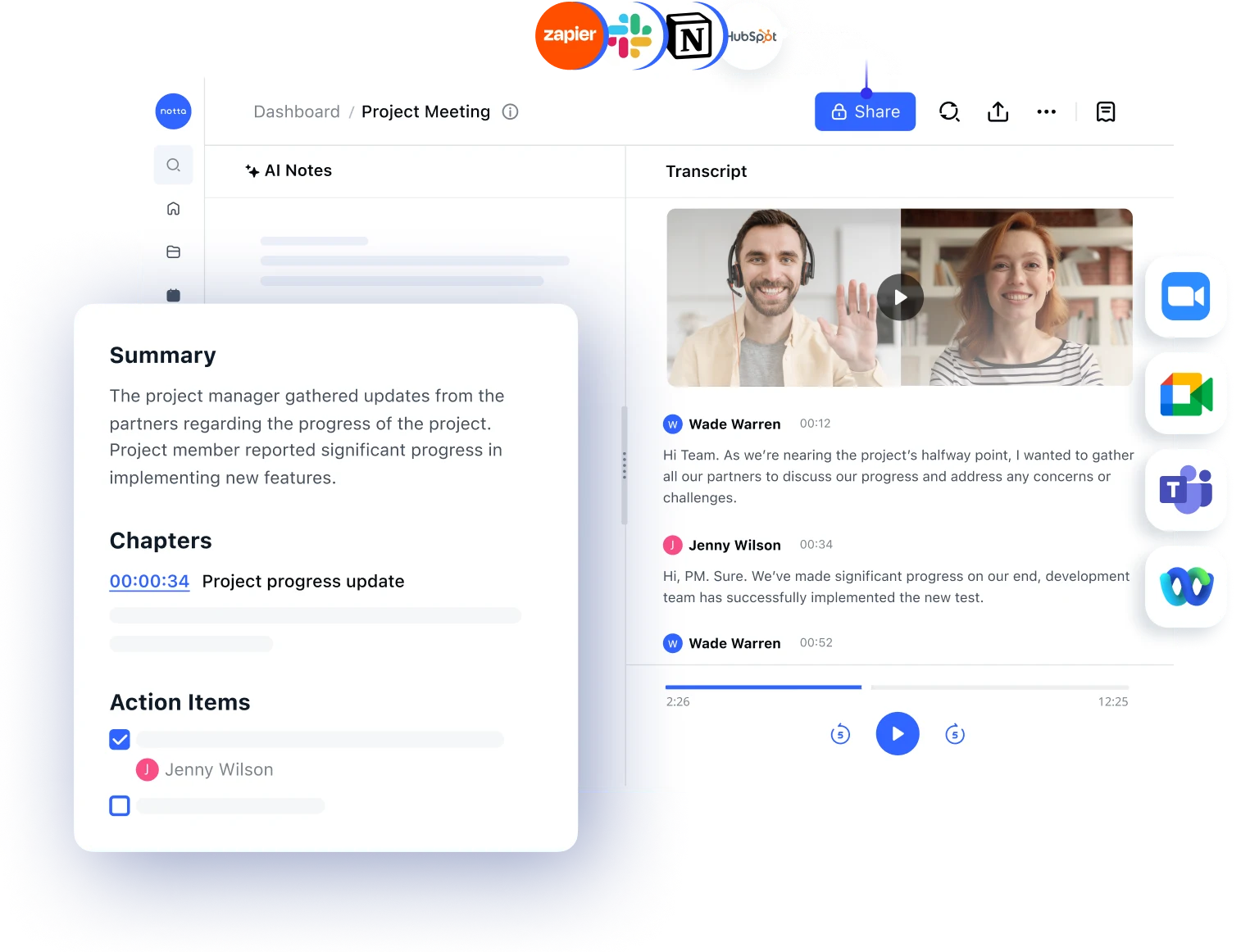When making a sales or discovery call, it’s of the utmost importance to take detailed notes. But besides capturing all the information shared, it’s also essential that you do it in a well-structured manner with actionable insights. If you work in sales and you’re struggling with taking effective sales notes during your calls, then I’m here to help.
Having worked in sales for several years, I’ve experimented with several approaches and have concluded that there are a few key things that make for good sales notes. In this guide, I’ll show you how you can do so as well.
What is a sales note?
A sales note is a document that outlines key details about your clients, which you can refer to when making key decisions. These notes must be well-structured, clear, and concise so every member of your team can access them whenever needed. Further, the detailed breakdown of the client’s preferences, goals, challenges, and opportunities is crucial to help you close a deal with the right approach to your pitch.
The importance of taking good sales notes
Capturing clear and concise sales notes is critical for several different reasons, including:
They help you capture relevant information: At a very basic level, the details captured in sales notes help you identify whether or not your prospect is a good fit for your product offering. This process becomes particularly important if you take several sales calls in a day as it ensures the information about each potential client is captured accurately and documented in a well-structured manner.
They increase sales teams’ success: Capturing valuable and detailed notes can benefit your entire sales team by enabling seamless collaboration to close deals quickly and more efficiently.
They help ensure quality control: Documenting accurate sales notes also helps sales managers understand how effective their sales process is and makes it easier to implement changes for greater success.
Capture every detail with AI meeting notes
Notta offers the most integrated AI meeting notes, summaries, and action items so nothing gets missed.
How to take the best sales notes in 5 steps
It’s now time to get into the nitty-gritty of taking the most effective sales notes. You must keep in mind that your Zoom meeting notes or those from any other video conferencing platform should be well-structured and capture all the key details you need about your prospects. Here’s how you can do this in five key steps:
Step 1: Create a comprehensive structure
You shouldn’t go into a sales call with no plan of action or idea about what to ask your prospects. This will be a waste of time, and you won’t capture the information you truly need to make a successful pitch later.
You should ideally think of every stage of the sales process, from prospecting and pitching to customer retention, and ensure that you capture all the relevant information to support you through every step of the process. Overall, your sales notes must capture the following details:
The prospect’s contact details
Pain points
Key points discussed
Willingness to buy
Opportunities
Goals
Result of the meeting (qualified/disqualified, follow-up, etc.)
You should ideally have a coherent format with all these details integrated into your CRM, which will allow you to capture well-structured sales notes each time. However, given that there’s always the potential to miss out on some details, it’s always wise to use an AI note-taking tool that can record and transcribe the meeting and give you a summary of it with the key action items for you to refer to. Notta is one of the best note-taking apps you can consider.

NOTE: Don’t document the entire discussion word-for-word, as this will take up a great deal of your time. Creating a predefined structure or format can come in handy, as it ensures that you capture insightful and actionable information.
Step 2: Make sure to personalize your notes
Taking sales notes shouldn’t be a robotic process but should be personalized to capture key personal details of the prospects you speak to. In fact, a report by McKinsey states that 76% of consumers are more likely to purchase from brands that personalize their marketing and sales content.
This goes to show the value of capturing key details that can help break the ice during your forthcoming interactions with your prospects. After all, sales today is about more than merely selling; it is about building and maintaining relationships in the long run.
Step 3: Ensure your notetaking is consistent
When you’re working as part of a sales team, you’re operating as one part of a whole, and the notes you capture are valuable to the organization. This is why it’s important that you keep your notes consistent to ensure that anyone within the sales team can access them with ease. This also helps them derive all the key insights needed to move a prospect further ahead in the sales pipeline.
Using standard fields in your CRM and specific sales jargon wherever appropriate can ensure that the information you’ve captured is easy to understand for anyone on your sales team.
Step 4: Clearly define each action item
A sales discovery call can lead to varying results. For example, you might have to follow it up with another call to dive deeper into the details of your prospect’s business and challenges, schedule a demo, or even pitch your product offering to the key decision-makers. Regardless of the outcome, it’s essential that you define clear action items for yourself and the other members of your sales team.
Using a tool like Notta can prove to be highly effective here as it can record and transcribe your meetings in real-time. It also generates a summary of the key action items at the end so you have a clear understanding of your next steps.
Step 5: Complete your notes and update your CRM
You might often take notes during a sales call only to be confused when you go through them a few days later. This is why it’s crucial that you complete your notes right after the meeting ends so you have a clear record of everything you discussed. These details must also be immediately updated in your CRM in a structured manner, so they are available and comprehensible for everyone on your sales team.
Efficient, productive meetings with Notta
Let Notta worry about the details so that you can focus on the meeting. Accurate, real-time meeting notes at your fingertips.
Sales call note templates
Now that you have a good idea of how to capture effective and concise sales notes, I’ll give you two sales note templates you can use to get started immediately.
Template 1 (During the call)
Basic details
Prospect’s name
Designation
Contact details
Purpose of the call
A list of the key points discussed + prospect’s response
Key pain points
A list of the key pain points your prospect currently faces as part of their existing workflow.
Readiness to buy
How close is the prospect to making a purchase? Do they need a follow-up call or a demo?
Result of the meeting
Define the result of the meeting. Were any decisions made? Do you need to give them a follow-up call? Outline these details and integrate any follow-ups with your calendar.
Personal side notes
Any personal side notes that strike you over the course of your call?
These could be personal details about the prospect that can help you personalize your sales pitch or key insights about their organization and decision-making process.
Template 2 (Sales follow-up)
Purpose of the meeting
Define the purpose of the meeting, including diving deeper into the prospect’s needs and challenges, presenting a demo of your product offering, etc.
Key points discussed
Highlight a list of the key points discussed, along with any mention of their willingness to purchase, key logistical and budgetary challenges, additional pain points, etc.
Demo
In your CRM, highlight whether you offered a product demo by using a Yes/No drop-down list.
Readiness to buy
Outline whether the follow-up resulted in an increase or a decrease in their readiness to purchase.
Result of the meeting
Highlight the result of the meeting in clear terms, along with any decisions made.
Personal side notes
List any personal side notes that could serve as valuable insights if the prospect has qualified for the next stage in the sales pipeline.
Avoid these sales note mistakes
When curating detailed sales call reports, there are certain things you must avoid to streamline your note-taking process and ensure it offers value down the line. These mistakes include:
Not taking any notes: As much as you might think you’ve got a great memory, chances are that not taking notes will inevitably result in you missing out on key details that can help you turn a prospect into a paying customer.
Taking lengthy, unstructured notes: Taking too many notes in an unstructured manner simply increases your workload, as you’ll then have to sort through them later to turn them into actionable details.
Neglecting your notes: When you’ve put great effort into taking concise and actionable sales notes, you must read through them before your next call to ensure you can tailor your pitch for the best chance of success.
Taking well-structured and coherent sales notes can help ensure greater success in the long run. They will streamline your sales efforts and ensure that every member of your sales team has access to high-quality, comprehensive notes.

